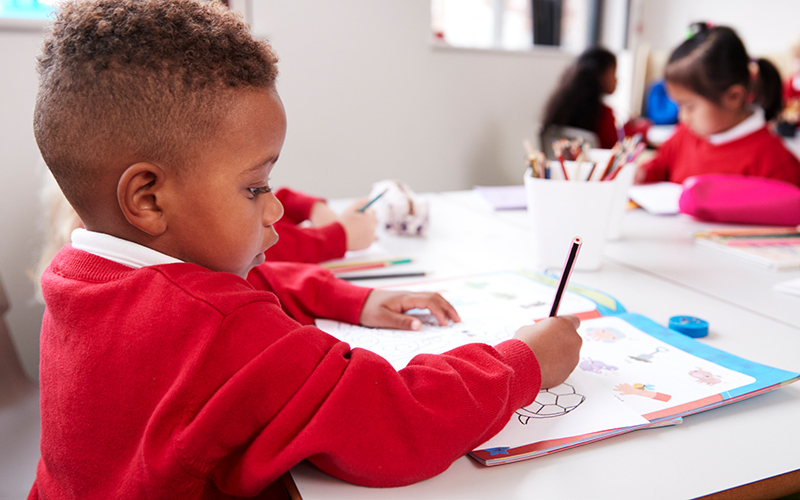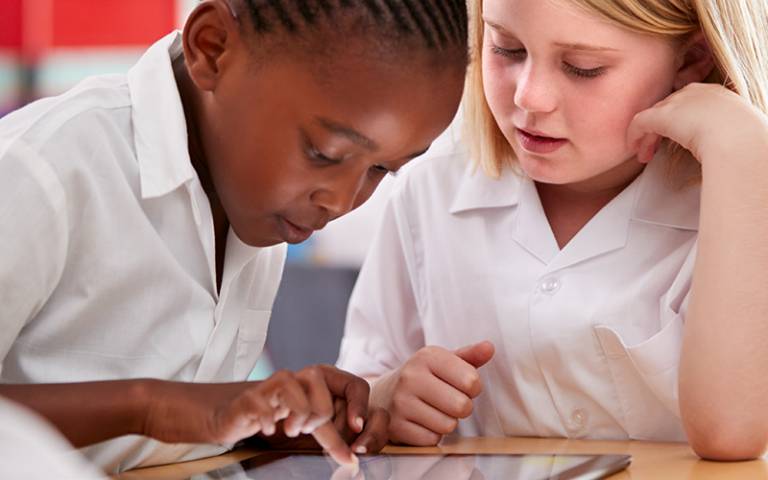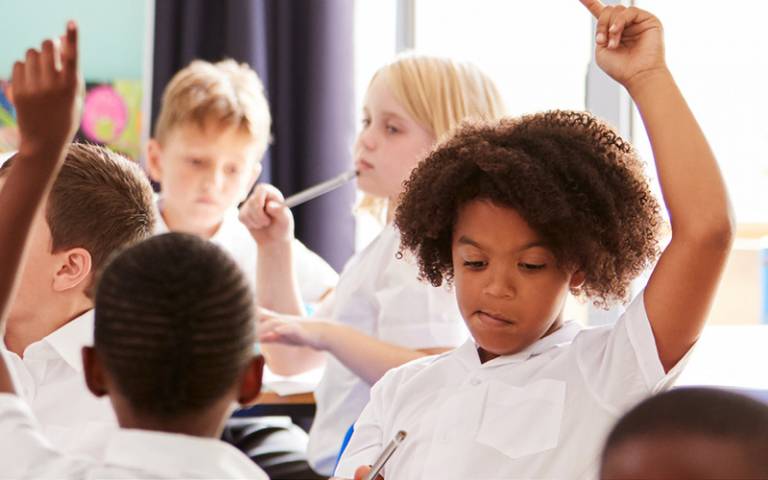Learning after lockdown
‘Recovery’, ‘catch-up’, or business as usual? Guiding primary schools in supporting pupil learning going forward.

9 October 2020
This briefing note sets out key findings from our research based on tracking primary schools’ responses to the crisis from lockdown onwards. The briefing is intended to help guide primary schools in supporting pupil learning going forward.
Teachers’ experiences of the COVID crisis have been hugely varied and influenced by the local circumstances that each school has faced. Schools and parents have had to grapple with difficult questions about how to keep everyone safe as well as keeping children engaged with education during turbulent times.
This has meant schools developing new ways of working and setting new priorities in order to best support their communities at this difficult time.
There are many different visions for how schools should respond to what has happened and prepare for what lies ahead. Here we set out what our research tells us about the following issues:
- Supporting pupils returning to school after a period of absence
- Setting priorities for learning in the light of diverse needs
- Preparing for further periods of disruption.
Key findings
Project findings are based on a survey of 1,653 primary school teachers in England, conducted through Teacher Tapp between May 27-29 2020; a follow up survey conducted by ILC between July 3-31st 2020; in-depth interviews with teachers, head teachers and system leaders; documentary evidence of the wider public debate on education and COVID-19; and a rapid evidence assessment of the relevant literature.
Finding 1: A settling in period will allow schools to better identify children’s needs
Overwhelmingly, our respondents prioritised children’s wellbeing as they planned for the new school year. School leaders and teachers recognise that wellbeing and purposeful learning are intertwined. Schools’ normal ways of working ensure these two elements interact: learning routines support pupil wellbeing and pupil wellbeing acts as a necessary foundation for learning. As one respondent commented:
Teachers will need to address children’s mental health issues and reintroduce children to school... there will need to be work on nurturing and bringing children back together as a class. This must be the priority - not whether they are meeting national end of year expectations!
The benefits of settling children back into the ‘normality’ of school routines were seen as equally important regardless of the levels of deprivation in the school community (Moss et al, 2020). Because pupils’ experiences during the pandemic have varied so tremendously, there can be no national “one size fits all” system of recovery. Some children will have been able to continue learning at home, especially if their home environment gives them easy access to technology, toys, books, and space. But some of our more vulnerable children living in poverty may lack those facilities and indeed have had little access to safe spaces in which to play and learn. Parents may have been less able to help with work sent home from school. Some will have been under considerable pressure, relying on food banks, struggling with long working hours, caring responsibilities or finding themselves jobless. All of this needs to be taken into account as children return to school. Schools will have different priorities depending upon how the COVID crisis has played out in their local community.

Finding 2: Priorities for learning in the light of diverse needs
Teachers have been rightly concerned about the impact of this period of disruption on children’s learning. These concerns are most acute for teachers working in our most disadvantaged communities. Our survey data show 71% of teachers working in the most deprived areas thought lockdown would have a significant impact on their pupils’ academic progression, compared to 45% in the least deprived. Of those who thought home schooling was working well, only 9% were working in the most deprived areas compared to 33% working in the least deprived areas.
How to deal with this disruption to learning is a challenge which all schools will have to address. As the teachers and head-teachers we interviewed have stressed, careful, teacher-led, formative assessment will be key here. This is part of every teacher’s daily professional practice. It is also one of the most important resources teachers can draw on in planning their curriculum during a period of uncertainty.
Our review of the literature (Harmey and Moss, 2020) and research studies published post COVID suggest that the most probable outcome of a period of learning disruption is an increase in the range of learning needs within each class (Kuhfeld et al, 2020). High quality mixed attainment teaching may be the essential starting point from which to address this. Whole class teaching with mixed attainment in mind allows teachers to re-engage children right the way across the attainment spectrum in purposeful learning. It also mitigates the risks of targeting resources too soon (See Hodgen et al, 2020). Some apparent learning gaps may be transitory rather than long lasting. Test and target too soon and children could be needlessly taken out of lessons from which they might actually benefit more (see also CEPEO 2020).
Teachers seem to instinctively recognise the value of reconnecting children to learning in this way. The government push to target low attaining students with catch-up programmes as a way of making up attainment gaps and SATs scores fast has won little support from our respondents. As one senior leader commented:
I just think “What do teachers normally do?” They have a sense of what they want children to learn. They work out what their gaps are and then they do their best to fill in the gaps through whatever version of pedagogy they think is most effective.
Given the considerable sum of money government has committed to this end, this might seem surprising (DfE 2020a). But the money has to be spent in particular ways, with an emphasis on buying in additional programmes or external tutor support. This leaves head teachers with little apparent discretion on how to tailor what they do to meet local needs. As one respondent commented:
Schools need more funding given directly to them to invest where it will have most impact for their unique groups of children.

Finding 3: Locally-responsive planning remains key
Schools and teachers have had to learn fast about how best to support learning through periods of disruption and under different conditions. During lockdown, many of our respondents said they had become more aware of the difficulties families face in sustaining children’s learning at home, sometimes under very challenging conditions.
Challenges for parents might come from the logistics – how to keep a particular age range of siblings purposefully occupied at the same time; or from the absence of necessary resources – maybe digital technology or a sufficient supply of children’s books; or the necessary competence and expertise to support unfamiliar school tasks. In response, teachers and heads spoke of helping parents and families identify and adapt learning routines that worked for them and that they could sustain. As one teacher noted:
the last thing I wanted to do was make a parent feel ‘I can’t cope’ because that’s what they were doing. That’s not right.
Most of our interviewees tried to achieve a careful balance, between supplying enough support or guidance to reassure parents and not overwhelming them by making demands with which they were unable to cope, given restrictions on their time or familiarity with the subject matter.
The government suggests that developing remote education should be a priority for schools to mitigate for future disruption (DfE, 2020b). This aim is complicated by our findings that many families lack sufficient devices or adequate internet access to make remote online learning possible. One head teacher stressed:
we’ve got 30% of children who are Pupil Premium and we have got others who are not far off, they haven’t got access to the technology, and neither has the school.
Closing the technological gap has not proved straightforward for government, with the promise of adequate access not fulfilled. Meanwhile, in a packed autumn term, with schools struggling with a range of other pressing priorities, finding time to review how digital learning can best translate into purposeful home-learning may be especially difficult for schools coming to this task for the first time.
In fact, in our data, teachers in schools with a higher proportion of pupils on free school meals were significantly more likely to prioritise supplying families with hard copy resources that did not require online access (Moss et al, 2020). The route schools take to support home learning in their communities should be respected: they should be encouraged to prioritise and resource professional development that will enhance their curriculum planning in the light of local needs (See also International Literacy Centre, 2020).
 Close
Close

